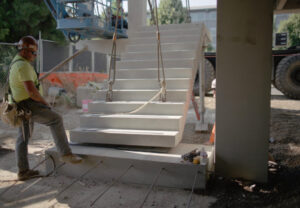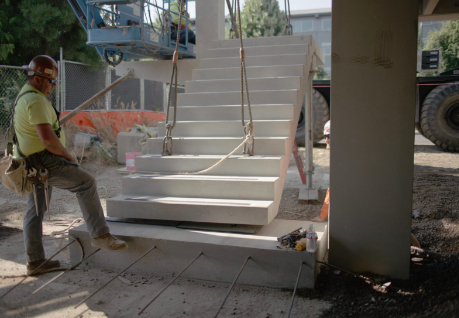Concrete stairs can add a welcome boost to your home’s curb appeal. Concrete Stair Installer can also be very durable. But they can be expensive to install. It is important to work with a professional to ensure that your new steps are strong enough for your family’s use. Removing and installing concrete steps is much easier than people expect. This demonstrates how to do it.
Concrete steps are a popular choice for exterior entryways to a home because of their durability and modern look. The average cost of a set of new concrete steps ranges from $900 to $5,000, including installation and removal of existing stairs. The size of the staircase, type of materials used, and additional features can affect the price. Whether the steps are poured or precast also impacts pricing. Poured steps typically cost more than precast.
Local building codes often require that concrete steps be anchored to the home’s foundation. This is especially important for outdoor steps, which can be subjected to heavy loads and harsh weather. Anchoring the steps to the foundation can add an extra $300 to $1,000 to the total cost of construction.
Some areas have strict requirements for the location of concrete steps, so it is best to consult a professional before installing them. They can help you choose the best location and ensure that the steps are safe for people to use. They can also recommend a contractor that can do the job well.
If you are replacing existing concrete steps, a professional can take care of the excavation and frame building process for you, which saves you money. However, the labor costs to remove existing concrete can run up to $400 per staircase. Some municipalities have additional fees for removing and disposing of concrete.
A DIY project may cost less, but it can be a complicated and time-consuming task for most people. The best way to avoid expensive mistakes is to hire a professional. They can ensure the steps are built correctly and won’t cause damage to the soil around your foundation.
Replacing concrete stairs is relatively inexpensive, but you need to budget for the costs of paint and protective coatings. It is recommended to choose a high-quality acrylic latex paint that can resist fading and UV rays. The paint will need to be reapplied after a year, so it is wise to hire a professional for this task. A concrete step repair kit is an inexpensive option for repairing minor cracks and holes.
Concrete stairs are a durable, low-maintenance option for your home. They can withstand the rigors of daily use, and they are easy to clean with a garden hose or pressure washer. They are also strong enough to support handrails, making them a safe and secure choice for households with mobility-challenged members. Concrete steps are available in a variety of styles, and they can be customized to fit your style or budget.
A basic concrete staircase can be made using simple materials. These include a mix of 3 parts cement, 2 parts sand, and 4 parts gravel, and a form to hold the concrete in place. The form should be sturdy and waterproof to prevent water seepage. It should be built in a level, flat spot. It is also a good idea to use an evaporation retardant, which slows down the curing process of the concrete and keeps it workable longer.
The concrete is poured into the form and allowed to set, which takes several days. After it has set, the form is removed and the steps are finished to the desired specifications. This may include smoothing the surfaces, cutting the edges, and adding any decorative elements. The finished product is then transported to the construction site and installed.
Precast concrete stairs are a popular choice for commercial and industrial buildings. They are easy to install and come in a wide variety of sizes and shapes. They can be customized to suit the requirements of each project, and they are often used in conjunction with precast wall panels or beams. They are also a great option for residential applications, as they can be installed quickly and easily.
Compared to poured concrete, precast steps are much cheaper. They are mass-manufactured, which cuts down on labor costs. They are also available in a wider range of styles and colors, so you can find one that fits your home’s decor. However, they are more expensive than poured concrete stairs, as they require more material to make. They are also heavier, so they are more difficult to transport and install on-site.
Some types of work require a permit before starting. These include: Adding a new driveway, building a deck, installing concrete stairs and more. A permit costs $100 and usually includes a professional inspection. A permit is needed because local authorities and building codes must be adhered to during the construction process. In addition, some homeowners’ associations have their own rules that need to be followed.
It is important that all permit applications are filled out completely and correctly. If there are omissions or errors, it can delay the issuance of the permit. In some cases, it can even result in a denial of the permit. The permit application should provide the scope of the project, plans and home owner or contractor information.
The permit process can take 4 to 90 days. It depends on the size and complexity of the project and whether or not an additional review is required before a permit can be issued. Homeowners and contractors should call the number listed on their permit to schedule inspections for the foundation excavation (before pouring concrete), rough-in, and upon completion. Permits that have not been inspected are subject to a double fee. It is also important that the permit is posted in front of the work site to be easily visible from the street.
Concrete stairs are an important addition to a home and require proper installation. They also require regular maintenance and repair. To avoid injuries, hire a professional to do the job. The expert will ensure that the stairs are safe to use. In addition, the contractor will ensure that the steps are anchored to the home’s foundation. Some localities may require that the stairs be secured to the foundation wall or slab.
The first step to installing concrete steps is to excavate the area. Then, a subbase is laid. This base protects the concrete from shifting and deterioration. A rebar cage also strengthens the structure. Then, a concrete mix is added and mixed thoroughly.
Once the concrete has been poured, it needs to be set. It takes at least a day for the concrete to fully set. In the meantime, workers should wear protective gear to avoid injury. They should also take care not to snag the newly-formed concrete with a sharp tool or object. It is also essential to keep a fire extinguisher on site.
It is important to follow all government and industry regulations when working with concrete. In addition, employees should wear personal protective equipment (PPE) to reduce risks associated with concrete cutting and coring. This includes a hard hat, safety glasses, dust masks, ventilation systems, gloves, steel-toed boots, and other appropriate safety equipment. Lastly, workers should document any hazards they encounter at work.
People who work with concrete and other construction-related materials are at a higher risk of sprains and other musculoskeletal disorders than the general population. This is due to the heavy nature of these materials, which can cause back strain and other issues.
Moreover, construction workers are at high risk of lung problems because of the amount of silica dust they inhale. To mitigate these risks, it is recommended to use a respirator or mask with a high particle filtration efficiency when working with concrete. The Occupational Safety and Health Administration has guidelines that cover these concerns.
In addition to PPE, workers should be trained in the specifics of concrete work. They should be familiar with the building codes, permits, and design requirements for stair dimensions and safety features. They should also be aware of any local hazard issues and communicate with each other clearly through hand signals or radios.
